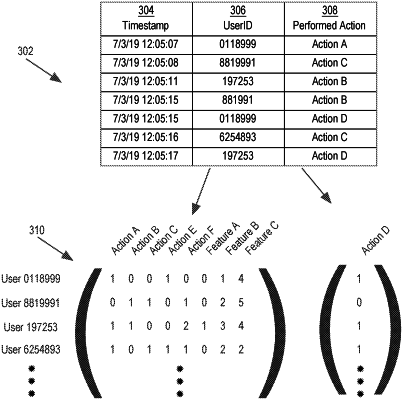| CPC G06N 20/00 (2019.01) [G06F 9/451 (2018.02); G06F 11/3438 (2013.01); G06F 11/3466 (2013.01); G06F 17/16 (2013.01); G06F 17/18 (2013.01); G06Q 30/02 (2013.01); H04L 67/535 (2022.05)] | 20 Claims |

|
1. A computing system comprising:
one or more processors; and
a non-transitory memory storing instructions that, when executed by the one or more processors, cause performance of:
receiving, for a particular interface, interaction data for a particular period of time which identifies a plurality of users and a plurality of actions performed by the plurality of users through the particular interface during the particular period of time;
identifying a particular action, from the plurality of actions, as an output variable;
generating a feature matrix comprising a plurality of rows corresponding to the plurality of users, and a plurality of columns corresponding to the plurality of actions, excluding the output variable;
receiving user data describing a plurality of attributes of the plurality of users;
using principal component analysis computing one or more confounding variables comprising a linear combination of a subset of the plurality of attributes using previous interaction data from a previous period of time prior to the particular period of time;
generating a covariate matrix for the one or more confounding variables, the covariate matrix comprising a plurality of rows corresponding to the plurality of users and a plurality of columns respectively corresponding to each covariate;
appending the feature matrix with the covariate matrix; and
training a machine learning model to predict the output variable using the appended feature matrix as inputs and a vector corresponding to performing or not-performing the particular action as an output.
|